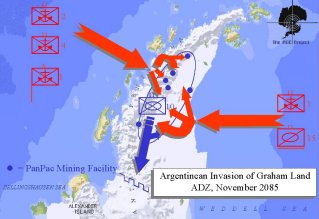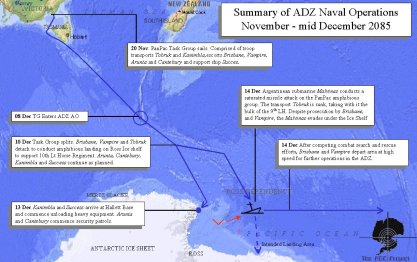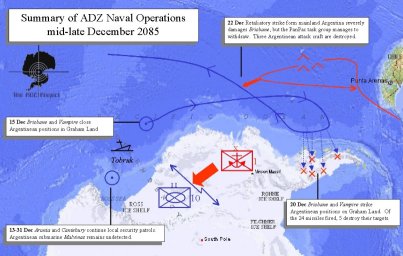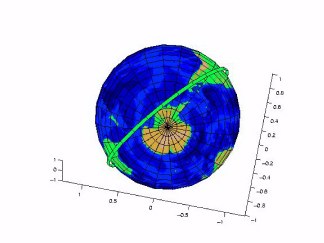November, 2085
Argentinean 1st Marine Brigade, reinforced by the 15th Light Armoured Cavalry Battalion, conducts a two pronged amphibious assault on PanPac facilities in Graham Land. After conducting covert landings on the Eastern side of the Peninsula, the 15th Cav and 1st Marine Bn conduct a rapid GEV advance over the Larsen Ice Shelf while the 2nd and 4th Marine Battalions conduct an amphibious assault on the west coast.
The PanPac 10th Light Horse Regiment, dispersed and unprepared, is stunned by the violence of the assault and the momentum of the offensive pushes all PanPac forces off the peninsula within a week. While some mining facilities were disabled or destroyed, many were captured intact and operational, some with substantial stockpiles of extracted ore.

By Mid November, a PanPac relief force based around the 9th Light Horse Regiment has been mobilised on mainland Australia and embarked in the bulk troop carriers Tobruk and Kanimbla for transport to Antarctica. Escorted by the PanPac Naval warships Brisbane, Vampire, Arunta and Cantebury, and with the tanker Success in company, the convoy sails on 20 Nov.
The Argentinean Marine Brigade, with a firm beach head established, commence pushing the 10th LH back over a wide front in late Nov. Small scale skirmishes reminiscent of the North African Campaign are indicative of the renewed offensive as PanPac trades space for time and awaits the arrival of the 9th LH.
December 2085
Argentinean forces continue to push PanPac back over the Hollick-Kenyon Plateau and Marie Byrd Land up to the Ross Ice shelf. It is here that the remnants of the 10th LH dig in to make a stand. The Argentinean Marine Bde, now relying on extended supply lines unfamiliar with operations in the harsh climate of the Antarctic steppes, are content to contain the 10th and survey their positions. Both sides are exhausted but continue to patrol and skirmish in a half-hearted manner.
The PanPac Naval convoy splits in response to the changed situation in the ADZ. The Vampire, Brisbane and Tobruk group alter course to conduct an amphibious landing behind the Argentinean Marines and take pressure off the beleaguered 10th LH. The remainder of the task group continues on to the PanPac base Hallet in Victoria Land.
On 14 Dec, Argentinean submarine Malvinas in a blocking position in the vicinity of the Ross Ice Shelf, conducts a saturated missile attack on the PanPac amphibious group. The transport Tobruk is sunk, taking with it the bulk of the 9th LH. Despite prosecution by the escorting frigates, the Malvinas manages to evade under the Ice Shelf.

The standoff between the forces ashore ends as the Argentinean Marines, heartened by the news that the 9th LH is on the bottom of the Southern Ocean, push harder. PanPac once again trades space for time as the forces embarked in Kanimbla are disembarked in Victoria Land to establish fallback defensive positions.
By 20th Dec, PanPac Frigates Vampire and Brisbane have moved to an area off Graham Land to conduct bombardment operations primarily targeting the captured PanPac mining facilities. Of the 24 nuclear tipped cruise missile launched by the two frigates, 5 tear their way through the hastily prepared Argentinean defenses to render the majority of the captured installations inoperative. A retaliatory strike form mainland Argentina manages to severely damage Brisbane, but the PanPac task group manages to withdraw both ships from the area.

Both PanPac and Argentinean High Commands now reevaluate the strategic situation. Both come to the realisation that they face a new and substantial threat; nuclear missiles utilising trajectories over the South Pole. The Great circle route over the pole minimises response time and passes over the Ross Ice Shelf and Marie Byrd Land which are devoid of early warning or defense systems. Given this new threat, the emphasis of operations in the ADZ immediately shifts from the enforcement of territorial claims and resources to the establishment of Early Warning and Missile Defense systems.

The Argentineans (now in possession of the war stocks promised by Pan Europe) and Pan Pac (with forces released from Northern Australia with the withdrawal of Nihon) mobilise new forces for service in the ADZ and modular Missile defense systems are cannisterised and packed for transport.
January 2086
Now...